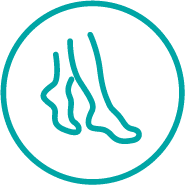Shingles and Postherpetic Neuraligia
Understanding Shingles Pain: Postherpetic Neuralgia, Risk Factors, and Treatment Options
Understanding Postherpetic Neuralgia
Postherpetic Neuralgia (PHN) is a severe, persistent pain condition that can occur following an outbreak of shingles, a reactivation of the varicella-zoster virus. This virus remains dormant in the body after a person recovers from chickenpox. When shingles damage the nerves, it can result in intense, prolonged pain, known as PHN. Despite shingles being a condition anyone with chickenpox can develop, only about 20% of people with shingles experience PHN.
Risk Factors and Treatment Options
The risk of developing PHN increases with age as the immune system naturally weakens, leading to the potential reactivation of the virus. This factor explains why most PHN patients are over 50. Regarding treatment, patients may consider nerve blocks for managing shingles pain. A comprehensive treatment plan from a pain management specialist may also include medications, topical treatments, and lifestyle modifications. These specialists provide personalized care, optimizing treatment effectiveness while considering each patient’s unique health situation.

Understanding Shingles Pain: Postherpetic Neuralgia, Risk Factors, and Treatment Options
Understanding Postherpetic Neuralgia
Postherpetic Neuralgia (PHN) is a severe, persistent pain condition that can occur following an outbreak of shingles, a reactivation of the varicella-zoster virus. This virus remains dormant in the body after a person recovers from chickenpox. When shingles damage the nerves, it can result in intense, prolonged pain, known as PHN. Despite shingles being a condition anyone with chickenpox can develop, only about 20% of people with shingles experience PHN.
Risk Factors and Treatment Options
The risk of developing PHN increases with age as the immune system naturally weakens, leading to the potential reactivation of the virus. This factor explains why most PHN patients are over 50. Regarding treatment, patients may consider nerve blocks for managing shingles pain. A comprehensive treatment plan from a pain management specialist may also include medications, topical treatments, and lifestyle modifications. These specialists provide personalized care, optimizing treatment effectiveness while considering each patient’s unique health situation.





Facts About Shingles Pain
Shingles vs PHN
Shingles and Postherpetic Neuralgia (PHN) both result from the reactivation of the varicella-zoster virus. However, PHN refers specifically to persistent pain following a shingles outbreak.
Commonalities
Both conditions manifest with intense pain and can significantly impact a person’s quality of life. Pain management specialists are vital in managing both shingles and PHN effectively.
Differences
While shingles typically present as a painful rash usually confined to one side of the body, PHN is the prolonged pain that can remain even after the rash subsides. This persistent pain can last months to years and requires specialized treatment.
Preventing Postherpetic Neuralgia: The Role of Nerve Blocks in Shingles Pain Management
Nerve blocks applied during the acute phase of herpes zoster infection (Shingles) can help shorten the duration of zoster-related pain. This intervention works by interrupting the pain signals sent from the affected nerves to the brain. The prompt application of nerve blocks, supervised by a pain management specialist, effectively manages acute pain and potentially decreases the risk of developing Postherpetic Neuralgia (PHN).
Somatic blocks, including paravertebral and repeated or continuous epidural blocks, are also recommended to prevent PHN. These techniques involve the injection of local anesthetics and anti-inflammatory medication near the affected nerves. This targeted approach can provide substantial relief, reduce pain intensity, and potentially prevent the onset of PHN, improving the patient’s quality of life.






Preventing Postherpetic Neuralgia: The Role of Nerve Blocks in Shingles Pain Management
Nerve blocks applied during the acute phase of herpes zoster infection (Shingles) can help shorten the duration of zoster-related pain. This intervention works by interrupting the pain signals sent from the affected nerves to the brain. The prompt application of nerve blocks, supervised by a pain management specialist, effectively manages acute pain and potentially decreases the risk of developing Postherpetic Neuralgia (PHN).
Somatic blocks, including paravertebral and repeated or continuous epidural blocks, are also recommended to prevent PHN. These techniques involve the injection of local anesthetics and anti-inflammatory medication near the affected nerves. This targeted approach can provide substantial relief, reduce pain intensity, and potentially prevent the onset of PHN, improving the patient’s quality of life.


Important Facts About Nerve Block Injections for Shingles and Postherpetic Neuralgia




Nerve Block Basics
Nerve block injections interrupt pain signals sent to the brain, providing relief for shingles and PHN patients. A pain management specialist typically administers these injections.




Treatment Timing
Administering nerve blocks during the acute phase of herpes zoster can shorten the duration of zoster-related pain. Early intervention may also reduce the risk of developing PHN.




Types of Blocks
Somatic blocks, including paravertebral and repeated or continuous epidural blocks, are often used in PHN prevention. These targeted techniques can significantly reduce pain and improve patient’s quality of life.
FAQ About Shingles and Postherpetic Neuralgia
Nerve block injections involve the targeted administration of local anesthetics and anti-inflammatory medications near the affected nerves. By blocking pain signals from reaching the brain, nerve block injections provide relief and reduce the intensity of pain experienced by individuals with Shingles Pain and PHN. The pain management specialist carefully administers the injections to ensure optimal effectiveness and patient comfort.
Pain management specialists utilize several nerve block injections to manage Shingles Pain and Postherpetic Neuralgia (PHN). Somatic blocks, such as paravertebral and repeated/continuous epidural blocks, are commonly recommended. These techniques involve the targeted injection of local anesthetics and anti-inflammatory medications near the affected nerves. Pain management specialists carefully administer these injections to provide relief and improve the quality of life for individuals experiencing Shingles Pain and PHN.
Nerve block injections are crucial in alleviating Shingles Pain and Postherpetic Neuralgia (PHN). These injections, administered by a pain management specialist, target the affected nerves and deliver local anesthetics and anti-inflammatory medications. By blocking the transmission of pain signals, nerve block injections relieve the intense pain associated with Shingles and help manage the persistent pain of Postherpetic Neuralgia (PHN). This approach allows individuals to experience reduced pain levels and improved quality of life.
Pain management specialists evaluate eligibility for nerve block injections as a treatment option for individuals with Shingles Pain and Postherpetic Neuralgia (PHN). Several factors, including general health, medical history, and an evaluation of pain intensity, determine the appropriateness of this technique. The pain management specialist makes a personalized decision based on the patient’s circumstances.
Nerve block injections are primarily a treatment option for managing existing Shingles Pain and Postherpetic Neuralgia (PHN) rather than for prevention. These injections aim to alleviate pain and provide relief once symptoms are present. However, consulting with a pain management specialist is essential, as they can assess individual circumstances and determine the most appropriate preventive measures and treatment options for Shingles Pain and PHN.
Multiple studies have shown positive outcomes, with pain reduction and improved quality of life reported by patients. According to a systematic review and meta-analysis of clinical studies, nerve block injections provided substantial pain relief for individuals with Shingles Pain and PHN. The analysis showed that approximately 70-90% of patients experienced pain reduction after receiving nerve block injections.
Specific preparations may be necessary before receiving nerve block injections for Shingles Pain and Postherpetic Neuralgia (PHN). These preparations are typically determined and guided by a pain management specialist. They may include evaluating the patient’s medical history, conducting physical examinations, and discussing any potential risks or complications associated with the procedure. The pain management specialist will ensure the patient is adequately informed and prepared for the nerve block injection, creating a safe and effective treatment experience.
During a nerve block injection for Shingles Pain and Postherpetic Neuralgia (PHN), the patient can expect a carefully guided procedure administered by a pain management specialist. The pain management specialist will thoroughly clean the area to be injected and may apply a local anesthetic to minimize discomfort. The pain management specialist will use imaging techniques, such as fluoroscopy or ultrasound, to locate the targeted nerves for injection. The injection involves the insertion of a thin needle to deliver anesthetic medication to the affected nerves. The patient may feel a brief sensation or pressure during the injection, but discomfort is typically minimal.
Patients can expect some temporary effects after a nerve block injection procedure as the anesthetic medication wears off. These effects may include localized numbness, temporary weakness, or a reduced sensation in the injected area. It is common to experience pain relief soon after the injection, lasting several hours or even days. However, individual responses may vary, and it’s important to note that the duration and level of pain relief can differ among patients.
While there is limited available data on post-procedure experiences, studies have shown positive outcomes and high patient satisfaction with nerve block injections for pain management. According to a systematic review of nerve block procedures, many patients reported immediate pain relief and improved functional outcomes following the injection. However, it is essential to consult a pain management specialist to understand the specific expectations and potential side effects of the nerve block injection procedure.
Individuals may respond differently to the effects of nerve block injections used to treat PHN and shingles pain. It depends on the medication used, the patient’s response to the injection, and the kind of pain that the nerve block injections aim to alleviate. The nerve block injection’s rapid pain alleviation often lasts a few hours to a few days. It’s crucial to remember that the length of pain alleviation can vary and may call for additional injections or different types of therapies for long-term management. A pain management professional can evaluate the patient’s health and offer more individualized information about the anticipated time frame for the nerve block injections for PHN and Shingles Pain.
There may be dangers and adverse effects from nerve block injections used to treat Postherpetic Neuralgia (PHN) and Shingles Pain. The injection site may experience a momentary tingling sensation, numbness, or weakness during and after the nerve block injection. At the injection site, there may occasionally be regional discomfort or bruising. Rarely the drugs used in the injection can cause allergic reactions. As with any medical operation, there is a slight chance of infection or nerve injury, but these side effects are infrequent when carried out by a skilled pain management specialist.
Various alternative therapies exist for treating Shingles Pain, Postherpetic Neuralgia (PHN), and nerve block injections. These alternatives include analgesics, antiviral drugs, and medications targeting nerve-related pain. Topical creams or patches containing lidocaine or numbing medications can provide localized relief. Physical therapy, acupuncture, and other therapies, including transcutaneous electrical nerve stimulation (TENS), can also be considered. A pain management specialist can assess the patient’s condition and recommend the most suitable treatment options based on their needs.
Types of Nerve Block Injections for Shingles Pain and Postherpetic Neuralgia (PHN):
Peripheral Nerve Blocks:
- Occipital nerve blocks (for head and neck pain)
- Intercostal nerve blocks (for chest and rib pain)
- Lumbar sympathetic blocks (for lower body pain) Spinal Nerve Blocks
- Epidural blocks
- Selective nerve root blocks Ganglion Blocks
- Stellate ganglion blocks (for upper body pain)
- Trigeminal nerve blocks (for facial pain)
Selection of Nerve Block Injections:
- The specific type of nerve block injection chosen depends on the location and severity of the pain experienced by the individual.
- A pain management specialist evaluates the patient’s condition and determines the most appropriate type of nerve block injection to provide targeted pain relief.


How may we assist you?
We are here to assist you in getting the care you need. Please provide us with your contact information, and we will reach out to help you schedule an appointment, verify your insurance coverage, or answer any questions you may have. Our top priorities are your health and well-being.
How may we assist you?
Find Your Nearest Clinic
Locate one of our clinics near you and prioritize your health today. Our top-rated medical centers offer multiple services and convenient locations to provide patients with needed care. Contact us today to schedule an appointment!
Find Your Nearest Clinic
Locate one of our clinics near you and prioritize your health today. Our top-rated medical centers offer multiple services and convenient locations to provide patients with needed care. Contact us today to schedule an appointment!
